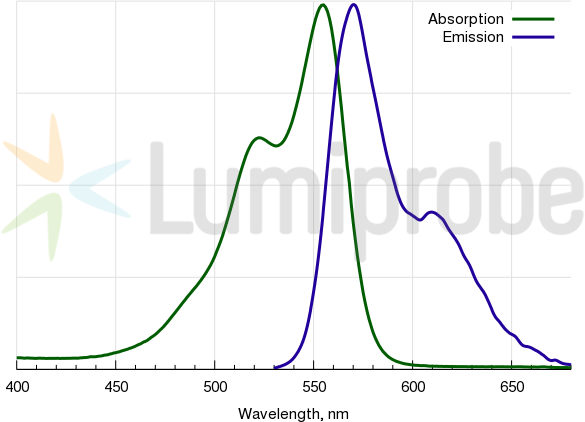Cyanine3 carboxylic acid
| Cat. # | Quantity | Price | Lead time | Buy this product |
|---|---|---|---|---|
| 11090 | 1 mg | $110 | in stock | |
| 21090 | 5 mg | $210 | in stock | |
| 41090 | 25 mg |
$410
|
in stock | |
| 51090 | 50 mg |
$695
|
in stock | |
| 61090 | 100 mg |
$1190
|
in stock |

Free Cyanine3 carboxylic acid (Cy3® carboxylic acid analog), non-activated dye. Non-sulfonated reagent, with good solubility in organic solvents and limited aqueous solubility. The dye can be used as a non-reactive fluorophore for control experiments, and for calibration.
For coupling with amines, and labeling, consider using Cyanine3 NHS ester, or water-soluble sulfo-Cyanine3 NHS ester.
Cyanine3 absorbance and emission spectra

Customers also purchased with this product
Cyanine3 azide
Azide derivative of Cyanine3 fluorescent dye for сlick сhemistry.BDP FL carboxylic acid
Borondipyrromethene dye for fluorescein (FAM) channel, free unactivated carboxylic acid useful as a negative control, and for the calibration.get free express delivery
sulfo-Cyanine3 azide
Water-soluble sulfo-Cyanine3 dye azide for click chemistry labeling of sensitive molecules and intact biological objects.General properties
| Appearance: | red powder |
| Molecular weight: | 493.08 |
| CAS number: | 1361402-15-4 (inner salt), 1032678-01-5 (chloride), 1251915-29-3 (iodide) |
| Molecular formula: | C30H37ClN2O2 |
| Solubility: | soluble in organic solvents (DMF, DMSO, dichloromethane), poorly soluble in water (1.8 g/L = 4.0 mM) |
| Quality control: | NMR 1H, HPLC-MS (95%) |
| Storage conditions: | Storage: 24 months after receival at -20°C in the dark. Transportation: at room temperature for up to 3 weeks. Avoid prolonged exposure to light. Desiccate. |
| MSDS: | Download |
| Product specifications |
Spectral properties
| Excitation/absorption maximum, nm: | 555 |
| ε, L⋅mol−1⋅cm−1: | 150000 |
| Emission maximum, nm: | 570 |
| Fluorescence quantum yield: | 0.31 |
| CF260: | 0.04 |
| CF280: | 0.09 |
Product citations
- De Pauw, E.; Chen, Y.; De Keersmaecker, H.; De Coninck, E.; De Smet, L.; De Geest, B.; Braeckmans, K.; Vervaet, C.; Vanhoorne, V. Drying Behaviour and Visualization of Surfactants after Co-Spray Drying of Surfactant-Stabilized Aqueous Suspensions. International Journal of Pharmaceutics, 2023, 643, 123231. doi: 10.1016/j.ijpharm.2023.123231
- Xu, S.; Zhang, P.; Heing-Becker, I.; Zhang, J.; Tang, P.; Bej, R.; Bhatia, S.; Zhong, Y.; Haag, R. Dual Tumor- and Subcellular-Targeted Photodynamic Therapy Using Glucose-Functionalized MoS2 Nanoflakes for Multidrug-Resistant Tumor Ablation. Biomaterials, 2022, 290, 121844. doi: 10.1016/j.biomaterials.2022.121844
- Mattila, J. T.; Beaino, W.; White, A. G.; Nyiranshuti, L.; Maiello, P.; Tomko, J.; Frye, L. J.; Fillmore, D.; Scanga, C. A.; Lin, P. L.; Flynn, J. L.; Anderson, C. J. Retention of 64Cu-FLFLF, a Formyl Peptide Receptor 1-Specific PET Probe, Correlates with Macrophage and Neutrophil Abundance in Lung Granulomas from Cynomolgus Macaques. ACS Infect. Dis., 2021, 7(8), 2264–2276. doi: 10.1021/acsinfecdis.0c00826
- Nishiyama, K.; Maeki, M.; Ishida, A.; Tani, H.; Hisamoto, H.; Tokeshi, M. Simple Approach for Fluorescence Signal Amplification Utilizing a Poly(Vinyl Alcohol)-Based Polymer Structure in a Microchannel. ACS Omega, 2021, 6(12), 8340–8345. doi: 10.1021/acsomega.1c00057
Cy® is a trademark of GE Healthcare.
The count of items is incorrect.














 $
$ 
